
CZ 527M Carbine
Scoping the CZ 527M carbine has been a contentious project for me. So much, in fact, that I decided to write a separate article so that you can learn from my mistakes should you decide to purchase a CZ 527M carbine and plant an optic on it.
For me, a receiver-mounted “peep” sight is so much better than using conventional open sights there is no comparison. NECG makes an excellent receiver sight for the integral 16mm rails of the CZ 527M. With that said, I did not want to upset the status quo; leave the original sight in place and add a magnified optic.
There are several challenges to meet when mounting a magnified optic on a carbine like the CZ 527M:
- Bolt handle to ocular (eye piece) housing clearance
- Eye relief
- Rear sight and/or barrel to objective housing clearance
The CZ 527M is a light carbine, not unlike the Ruger M77 in pistol caliber configuration. As the eyes get older, using the open sights become more of a challenge and the obvious solution to this problem is to mount a magnified optic. With a carbine like the CZ 527M it is very easy to “over-burden” the firearm with too much scope. The primary objective is “light and low.”
This particular carbine fires the 7.62x39mm cartridge, which is known to be an “intermediate” cartridge with ballistics comparable to the .30-30 Winchester and .300 Blackout cartridges. Being the bolt-operated firearm, this means that felt recoil is greater than with semi-automatic firearms with gas-operated actions. The magnified optic must be able to withstand the recoil of the cartridge. Fortunately, most magnified optics (and non-magnified optics) for center-fire firearms have no problems with recoil these days.
The CZ 527M comes equipped with 16mm scope mounting bases front and rear of the ejection port. Aside from the width of the scope mounting bases, the rear base has an inset that mates with a proper-selected rear scope ring to prevent movement on the base from the effects of recoil. The CZ 527M does not come with a set of scope rings, which is alright by me. Like other CZ owners have done, I would opt not to use them.
One of the first things that I learned when trying to select scope rings is that not all scope rings heights are the same. Since the CZ 527M did not come with a set of scope rings, I had no baseline to work with for selecting a scope ring height that, I felt, would be desirable. I had an unused 3-9×40 and a 4×32 scope that I could try to determine what actual scope ring height I would need. Everything is a trade-off when it comes to scopes; you can spend as little or as much on a magnified optic as you wish. While I wanted a decent scope, I did not want to break the bank account. The same applies to scope rings, both scopes and rings are in abundance, and mistakes can be costly.
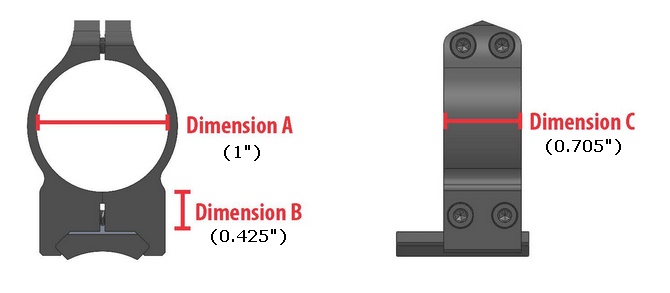
Warne 1B1M 1 inch CZ 527 Fixed Medium Matte Ring Dimensions
I decided that I wanted a quad-mount 1” scope of medium height. I felt that this ring would secure the selected magnified optic well enough and also provide enough clearance between scope and the rear sight – depending on the selected scope. Originally, I was looking for a 2-7×32 (or thereabouts) magnified optic with a 1” tube. The Warne 1B1M 1 inch CZ 527M Fixed Medium Rings 16mm Dovetail Medium scope rings were selected, as these rings received high reviews for use with the CZ 527M. I have used Warne rings in the past, and although a little bit trickier to use relative to top-mount rings, they are well worth the effort. The Warne ring set adds 5.3 ounces to the weight of the CZ 527M. The Warne 1B1M rings have a sight height (Dimension B) of 0.425-inch. As long as I did not have to move the scope to far forward, I did not have to worry about the rear sight height. The Warne 1B1M 1 inch CZ 527M Fixed Medium Rings 16mm Dovetail Medium scope rings also have a locking pin for the rear mount that fits into the slot in the CZ mount to hold the rings tight in place and prevents movement. I have found that Warne scope rings to be some of the strongest scope rings on the market.
Most ballistic programs use a 1.5″ scope height as a standard for determining ballistic qualities of a cartridge when fired from a rifle with a mounted scope. Below is a simple formula for roughly determining the scope height with a scope already mounted.
- Measure the bolt diameter and divide it in half. Example: 0.700″/ 2 = 0.350″
Measure the scope tube diameter and divide it in half. Example: 1.000″ / 2 = 0.500″ (Note: for 30mm tubes use 1.181”) - Measure the distance from the top of the bolt in the rifle to the bottom of the scope on the rifle. Example: 0.750″
- Add the numbers found in the formulas in steps 1-3. Example: (0.350″ + 0.500″ + 0.750″= 1.600″)
What the formula does not take into account is scope-to-barrel clearance, or scope-to-rear sight clearance for that matter. As a rule of thumb, low scope rings will accommodate a 28mm to 32mm objective lens and provide enough barrel-to-scope clearance. Similarly, a medium height scope ring will accommodate a 32mm to 44mm objective lens and provide enough barrel-to-scope clearance. Note that it is not the objective lens that we are concerned with; it is the objective lens housing. A 40mm objective lens will reside in a larger objective lens housing. For example, I have a Simmons 4x32mm scope where the objective lens resides in a 38.5mm objective lens housing. A Bushnell 3-9x40mm scope that I have actually measures 47mm at the objective lens housing. A Nikon Prostaff 3-9×40 scope exhibits an objective lens housing of 48.75mm. A few silly millimeters can make the difference between a scope mounting being successful – or not – as you will come to realize later in this article.
Likewise, the ocular lens housing plays a critical role in choosing a magnified optic; a role that become more critical with a bolt-action rifle than with a semi-automatic or a lever-action long-gun.
While not trying to make this subject into a tutorial, I am trying to bring out that mounting a scope on a rifle can be as simple as selecting a ring set, a scope, and the mating of such to a firearm may go smoothly, or there may be complications that you have to work through. In the case of the CZ 527M, there were some complications that I had to work through, and money to pay for mistakes was not in the budget.
The ocular lens (the eyepiece) housing size can be a heart breaker when attempting to mount a scope, especially with a bolt action rifle or carbine. The bolt handle must clear the ocular lens housing during the time it is extracting a spend shell and chambering a fresh cartridge. I have found that ocular lens housing dimensions are not always as accurate as provided by the manufacturer. For example, I have a Nikon Rimfire II 3-9×40 that, as claimed by Nikon, has an ocular lens eyepiece diameter of 44mm. An actual measurement reveled that the ocular eyepiece out diameter is actually 38.9mm. I have also discovered that what may seem to work may not when fitting a scope to a firearm.
As I mentioned at the beginning of this article, the CZ 527M has been one of the more contentious of long guns to fit a scope. This is due in part that not only does the curvature of the bolt handle and the distance of the bolt handle’s knob have to be taken into consideration, but the bolt handle base must also be factored in.
The bolt handle base, where it meets the bolt, adds approximately 0.481 inches (12.23mm) to the height of the bolt. In fact, when the bolt handle is in its full upward position, the base of the bolt handle actually exceeds the height of the scope mounting base of the receiver. If the ocular lens housing is too large, the base of the bolt handle would strike the ocular lens housing and that is not a good thing. Also to consider is that the bolt does not move simply forward and back; it also has lateral play and can also move up and down and left and right as it travels through its path. There has to be a balance struck between scope ring height and ocular lens housing to ensure that the proper clearance is available. The bolt handle travel, when moving from a full lock position and a full release position, is almost 90 degrees.
Once the Warne scope rings were set loosely in place, I could use a Nikon Prostaff Rimfire 3-9x40mm scope that I had as a test device to see if such a scope would clear in all areas. The Nikon Prostaff Rimfire 3-9x40mm scope is the same dimension as the Nikon Prostaff 3-9x40mm scope that is used for larger calibers – or so I thought.
CALLED OUT AT FIRST BASE – THE PROSTAFF 3-9×40MM SCOPE:
First, let’s take a look at some basic specifications.
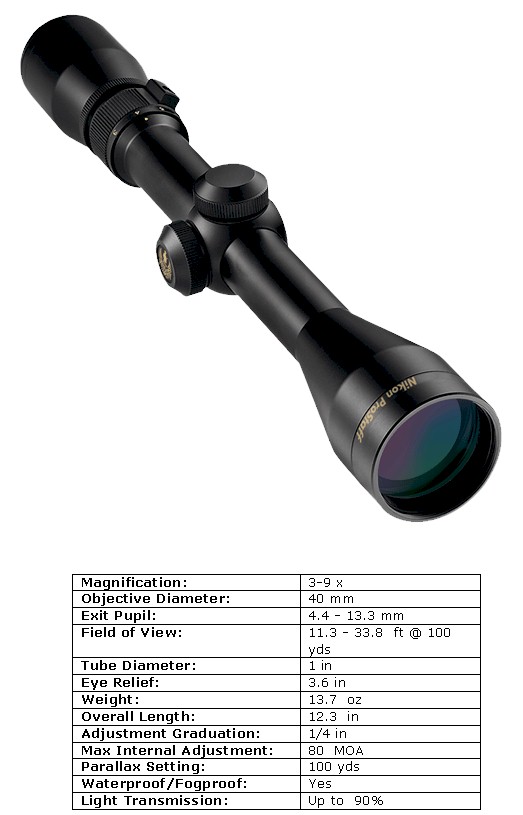 Physical dimension are shown below:
Physical dimension are shown below:

The Nikon Prostaff Rimfire 3-9x40mm scope was a perfect fit. There was plenty of clearance between the bolt handle in all respects, and the objective lens would nestle nicely just behind the rear sight. I was somewhat concerned with the front sight hood, but that turned out to be no problem at all since at the lowest magnification setting the scope looked beyond the front sight.
As I stated earlier, my original intent was to mount a 2-7x32mm scope; however, I dropped that intention after mounting the Nikon Prostaff 3-9x40mm scope. The scope looked well-balanced on the CZ 527M and the CZ 527M looked well-balanced with the scope mounted. I could not have asked for a better combination. The Nikon Prostaff 3-9x40mm scope was ordered through Optics Planet. The appropriate Scope Shield was ordered to protect the scope because I could no longer use the scope covers that would come with the scope due to the scope-to-rear sight clearance. The Scope Shield product is my favorite for protecting a scope.
When the Nikon Prostaff 3-9x40mm scope hit the door, my usual scope mounting procedure was performed, all screws were tightened to the recommended (by Warne) twenty-five inch pounds of torque, and before long I had a solidly-mounted and perfectly-leveled scope. Unfortunately, there was an issue – bolt clearance.
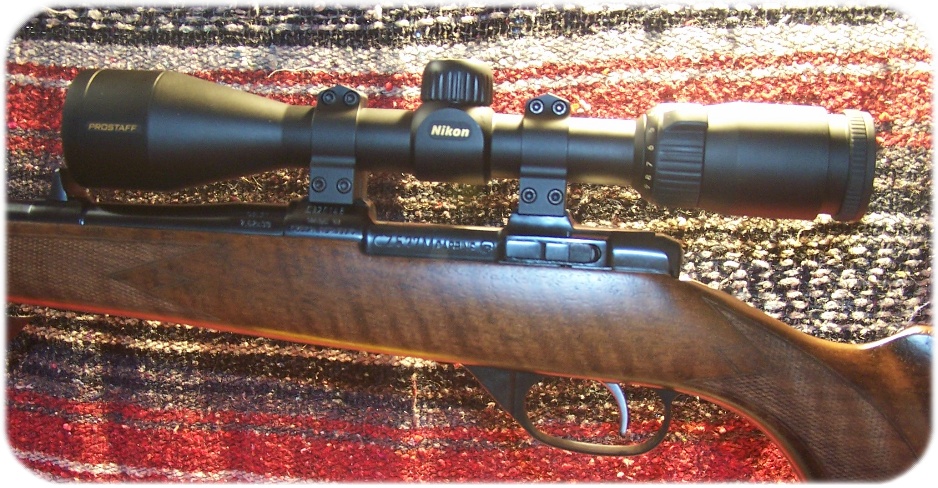
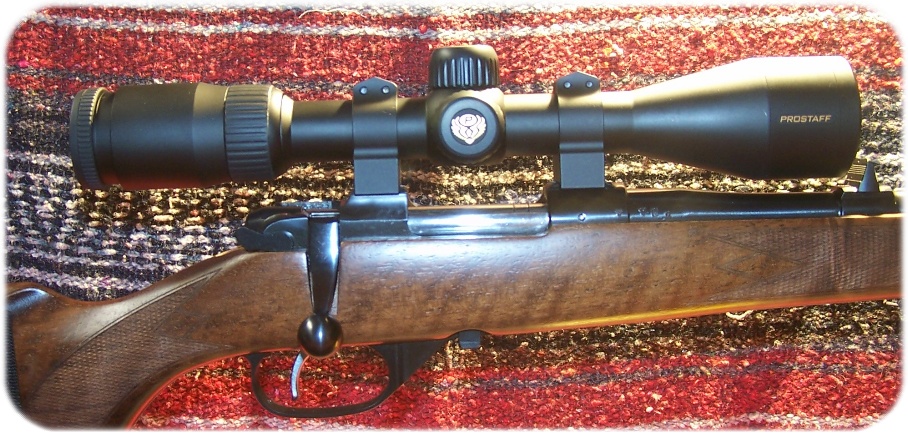
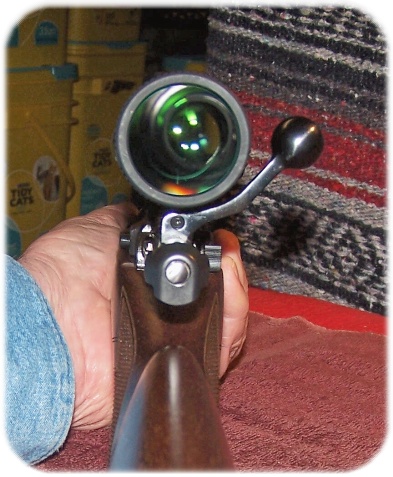 The ocular (eyepiece) lens housing on the Nikon Prostaff 3-9x40mm is slightly larger than that on the Nikon Prostaff Rimfire 3-9x40mm. Being “slightly larger” meant that I only had about 0.030 inch (0.762mm) of clearance between the base of the bolt handle and the bottom of the ocular lens housing with the bolt fully retracted. I was not a happy camper, at this point. There was enough clearance between the stem and the knob of the bolt handle and the ocular lens housing, but with not enough “comfortable” clearance between the base of the bolt handle and the bottom of the ocular lens housing, this mounting was not going to work.
The ocular (eyepiece) lens housing on the Nikon Prostaff 3-9x40mm is slightly larger than that on the Nikon Prostaff Rimfire 3-9x40mm. Being “slightly larger” meant that I only had about 0.030 inch (0.762mm) of clearance between the base of the bolt handle and the bottom of the ocular lens housing with the bolt fully retracted. I was not a happy camper, at this point. There was enough clearance between the stem and the knob of the bolt handle and the ocular lens housing, but with not enough “comfortable” clearance between the base of the bolt handle and the bottom of the ocular lens housing, this mounting was not going to work.
It seemed that I had two choices; purchase a “high” set of scope rings or purchase a scope where the ocular lens housing is smaller, as compared to that on the Nikon Prostaff 3-9×40. The former would bring its own set of challenges.
A higher set of rings would mean that the scope would sit higher on the receiver. That could mean that I might have to get a higher purchase on the stock of the rifle to obtain a proper sight picture. Of course, this could be rectified by adding a “cheek rest” to the stock, but that is something that I did not want to do. I wanted to use my current Warne 1” medium scope rings.
The second option was to find a scope with a smaller ocular lens housing than the Nikon Prostaff 3-9x40mm scope. I came to the realization that a Nikon scope was not going to work, as most of the suitable scopes all had an ocular lens housing of the same diameter; 1.73 inches. I was forced to look at other scope options.
SLIDING INTO HOME – THE LEUPOLD VX-1 3-9x40mm SCOPE:
I had read good reports on the Leupold VX-1 3-9x40mm scope and perused the specifications for the scope at Leupold’s web site. The Leupold VX-1 3-9x40mm scope would be the most expensive scope that I have ever mounted on a rifle – ever. But, a decision was made after comparing the Leupold VX-1 3-9x40mm scope with other alternatives, and the Leupold VX-1 3-9x40mm scope was soon on its way to me.
Here is the skinny on the Leupold VX-1 3-9x40mm scope:
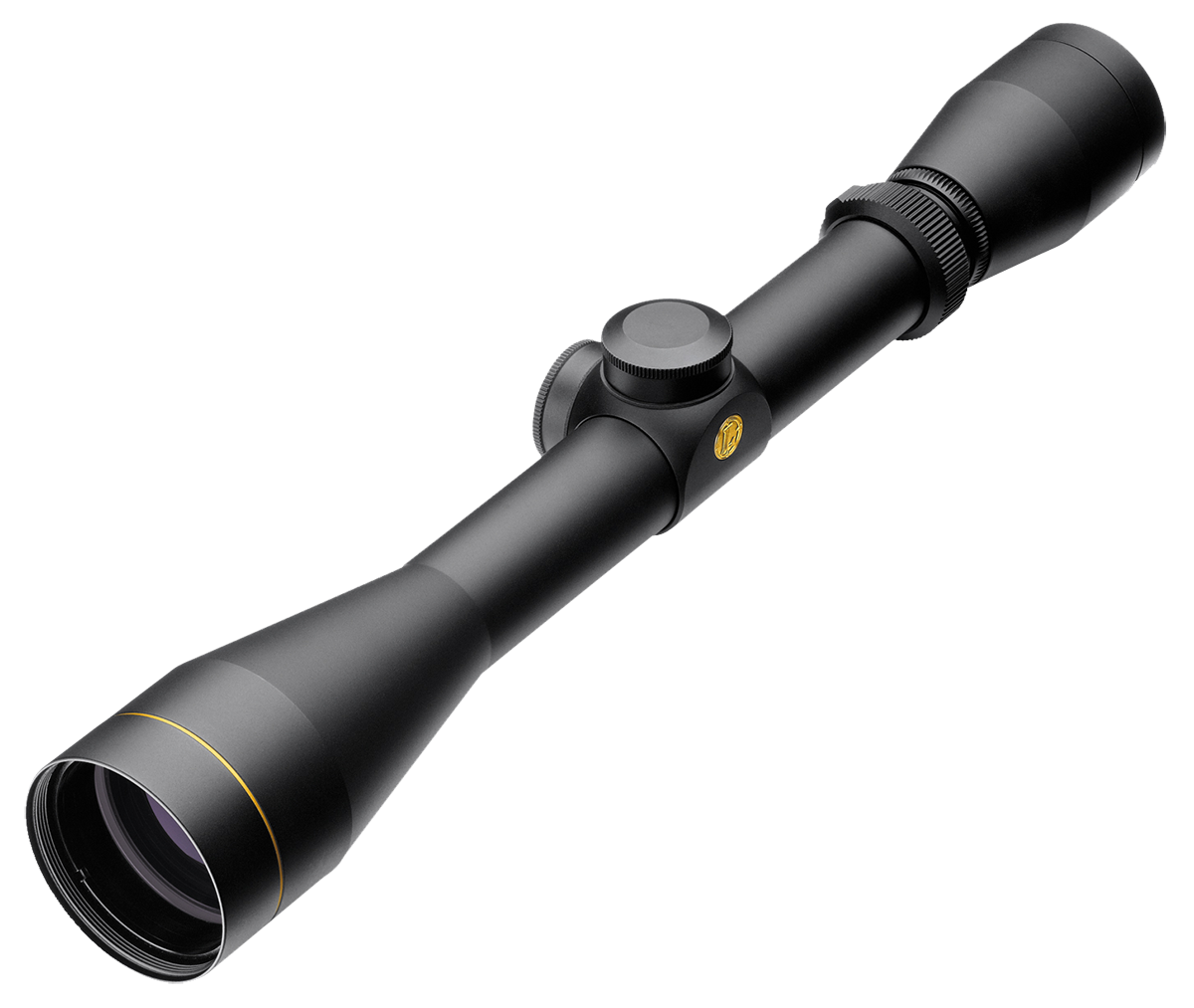
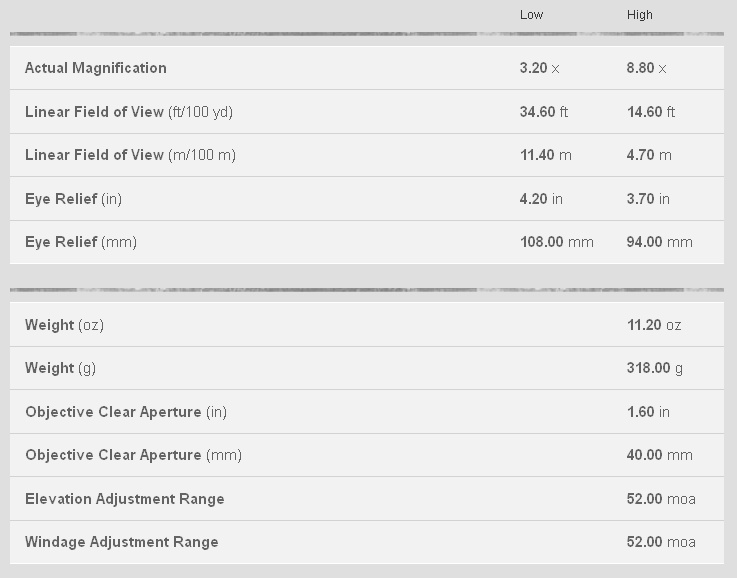
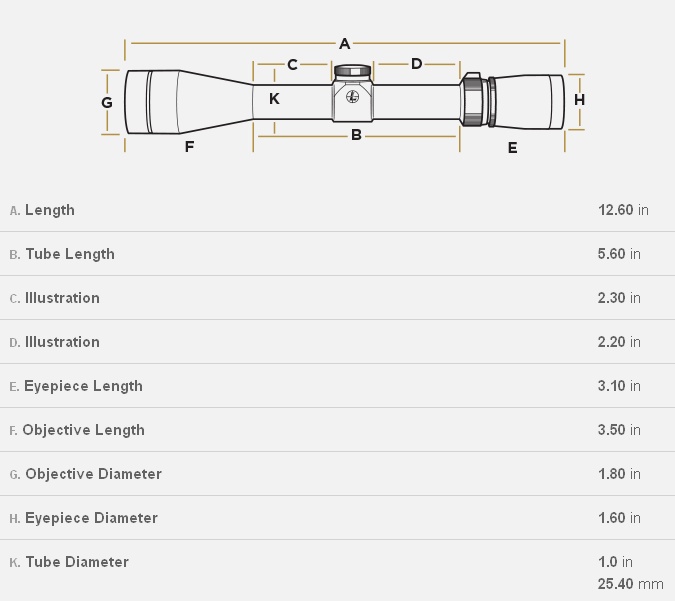 The Leupold VX-1 3-9x40mm scope, as compared to the 1.73 inches of the Nikon Prostaff 3-9x40mm scope, has an eyepiece diameter of 1.60 inches. The total length of the Leupold VX-1 3-9x40mm scope is slightly longer than the Nikon Prostaff 3-9x40mm scope (12.6 inches vs. 12.25 inches) and I was hoping that this would not be an issue, because I wanted to keep the rear sight of the CZ 527M carbine on the firearm.
The Leupold VX-1 3-9x40mm scope, as compared to the 1.73 inches of the Nikon Prostaff 3-9x40mm scope, has an eyepiece diameter of 1.60 inches. The total length of the Leupold VX-1 3-9x40mm scope is slightly longer than the Nikon Prostaff 3-9x40mm scope (12.6 inches vs. 12.25 inches) and I was hoping that this would not be an issue, because I wanted to keep the rear sight of the CZ 527M carbine on the firearm.
The weight of the Leupold VX-1 3-9x40mm scope, at 11.2 ounces, is less than the weight of the Nikon Prostaff 3-9x40mm scope (13.7 ounces). That meant that I could keep the CZ 527M carbine as light as possible, even if it was only by a few ounces.
The eye relief of the Leupold VX-1 3-9x40mm scope is 4.2 to 3.7 inches (depending on magnification); whereas, the eye relief of the Nikon Prostaff 3-9x40mm scope is slightly different, but not by much. Most of the issues noted by others, and in regards to eye relief when mounting a scope on the CZ 527M carbine, has been that the scope had to be pushed forward, more than some liked, to obtain the correct eye relief (which is measured at full magnification). Personally, I like to place the scope where it needs to be placed and move my head forward or backward to obtain the proper eye relief. If I need more distance from the scope, a slip-on recoil pad usually accommodates that. I have no desire to be whopped in the head by the rear of a scope.
The Leupold VX-1 3-9x40mm scope arrived a few days after purchase and I set about mounting it with the Warne 1” medium rings.
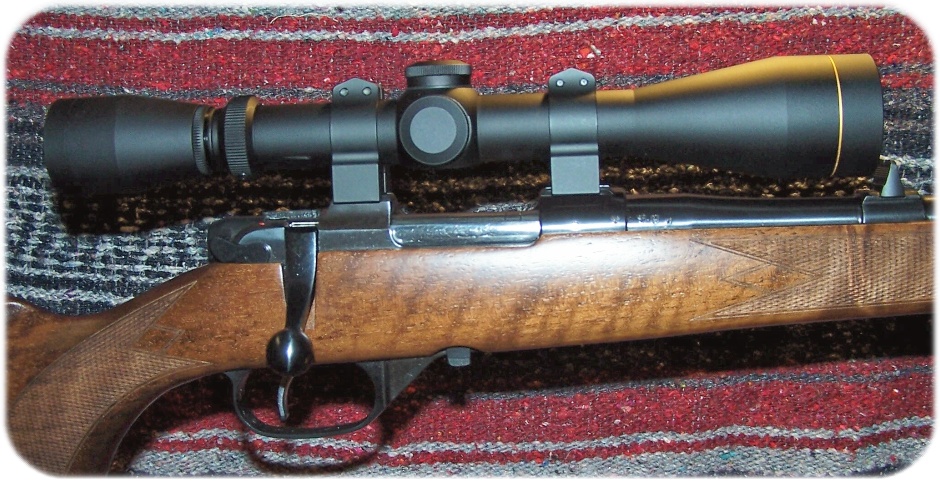
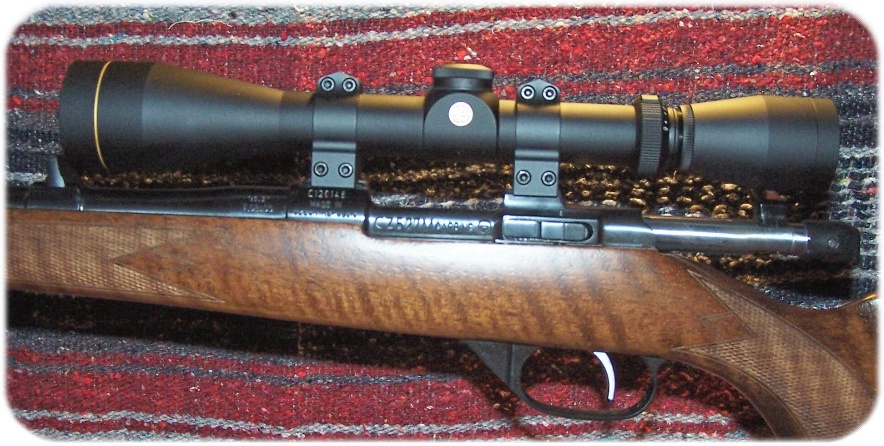 The installation and alignment went as planned and the Leupold VX-1 3-9x40mm scope was securely mounted atop the CZ 527M carbine, and which I hoped to be the last time setting a scope in place on this firearm. The Leupold VX-1 3-9x40mm is slightly longer than the Nikon Prostaff 3-9×40, which meant that the eyepiece would be slightly more to the rear of the firearm after adjusting the scope for my desired space between the objective lens housing and the rear sight, which I was determined to keep on the CZ 527M. When shouldering the CZ 527M, the eye relief could not be more perfect for me. While I like the elevation turret to be centered in the rings, I knew that I was going to have to accept that, in this case, it would not be centered.
The installation and alignment went as planned and the Leupold VX-1 3-9x40mm scope was securely mounted atop the CZ 527M carbine, and which I hoped to be the last time setting a scope in place on this firearm. The Leupold VX-1 3-9x40mm is slightly longer than the Nikon Prostaff 3-9×40, which meant that the eyepiece would be slightly more to the rear of the firearm after adjusting the scope for my desired space between the objective lens housing and the rear sight, which I was determined to keep on the CZ 527M. When shouldering the CZ 527M, the eye relief could not be more perfect for me. While I like the elevation turret to be centered in the rings, I knew that I was going to have to accept that, in this case, it would not be centered.
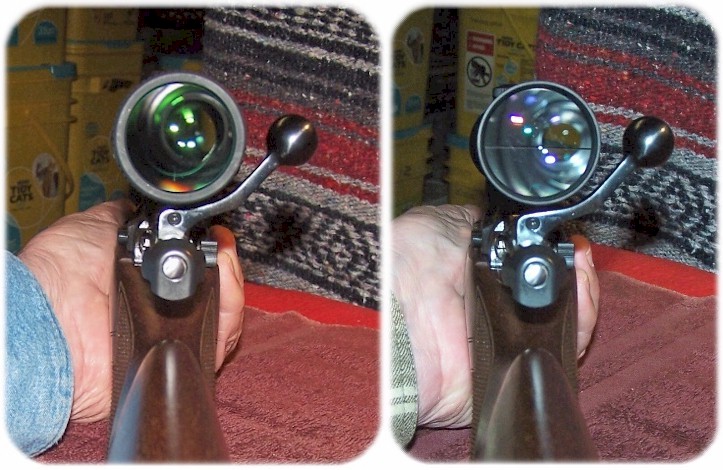
Comparison Between Nikon Prostaff 3-9x40mm (left) and Leupold VX-1 3-9x40mm Scopes
There was more than enough clearance between the bolt handle knob, the base of the bolt handle, and the bottom of the eyepiece housing for operating the bolt without worrying myself about the bolt hitting the scope. I finally had found a proper fitting scope-to-rifle combination. This was about as good as it was going to get.
While the difference between scope mounting and clearance may not look that substantial in the comparison image, in reality the difference of 0.13 inch can make the difference between an operating system and one that is not operational. Note the difference in eyepiece housing sizes between the Nikon Prostaff 3-9x40mm scope (left) and the Leupold VX-1 3-9x40mm (right) scopes.
The low profile of the Leupold VX-1 3-9x40mm scope lends well to the low-profile look of the CZ 527M carbine and I think that the combination will work fine for me.
I don’t even notice the additional weight of the scope on the rifle.
The rubber “bikini” scope covers were quickly discarded and replaced by a Scope Shield product, which is one of my favorite means of scope protection.
And, in case you are wondering, the rear and front sight cannot be seen in the scope; the lowest amount of magnification (3X) allows the scope to “look beyond” the rear and front sights.
THE HOME RUN:
Although I liked the Leupold VX-1 3-9x40mm scope, I didn’t like the fact that the scope could not be centered within the scope rings; it’s just a quirk of mine. The search for a suitable magnified optic continued.
If you have read my article on mounting optics on the Henry AR-7 U.S. Survival rifle (Optics and the Henry AR-7 U.S. Survival Rifle Is the Challenge Worth It?: https://guntoters.com/blog/2017/03/20/optics-and-the-henry-ar-7-u-s-survival-rifle/), one of my main concerns was finding a magnified optic with enough eye relief to satisfy my eye relief requirement. I found that this also applied to the CZ 527M Carbine; thus, this article is dedicated to a scope that was (and still is) intended to mount on the Henry AR-7, but found it way to the CZ 527M Carbine.
FROM THE MANUFACTURER:
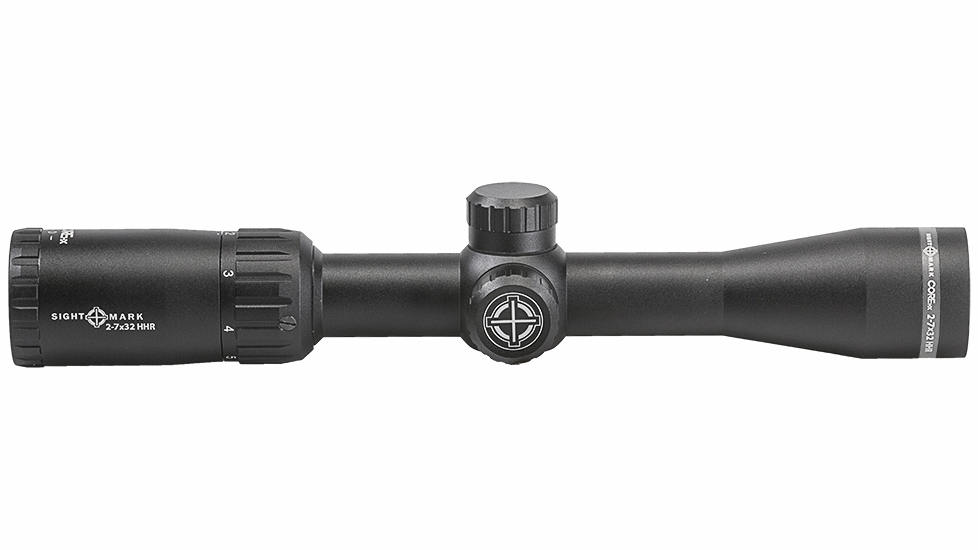
Sightmark Core HX 2-7×32 HHR Hog Hunter Riflescope
Features:
- IP67 – waterproof and dustproof
- Range-finding reticle designed for feral hogs
- Wide field of view for quicker target acquisition
- Single-piece, 1″ tube
- Aircraft grade aluminum
- Hard anodized finish
- Resettable, Capped turrets
- Shockproof, fog-proof, waterproof
- Multi-coated optics
Specifications:
| Body Material | Aluminum |
| Diameter, Exit Pupil | 32 – 4.5 mm |
| Diameter, Eyepiece | 1.65 / 42 mm |
| Diameter, Objective Lens | 32 mm |
| Diameter, Tube | 1/25.4 in/mm |
| Diopter Adjustment | +2 to -2 |
| Elevation Range of Adjustment | 70 MOA |
| Eye Relief | 4.7-4 / 119.4-101.6 in/mm |
| Field of View | 18.1 – 4.8 m @100m |
| Field of View | 54.4 – 14.4 ft @ 100yd |
| Finish/Color | matte black |
| Focal Plane | 2nd |
| Fog Proof | yes |
| Height | 1.87/47.5 in/mm |
| IP Standard | IP67 – waterproof and dustproof |
| Length | 11.26/286 in/mm |
| Lens Coating | Multi-coated |
| Magnification | 2-7 |
| Material, Lens | glass |
| Maximum Recoil | 1,200 g’s |
| MOA Adjustment | 1/4 MOA per click |
| Nitrogen Purged | yes |
| Operating Temperature | 0-120 / -17 to 49 °F/°C |
| Parallax Setting | 100 yds |
| Reticle | Metal |
| Reticle, Illuminated | No |
| Reticle, Type | HHR Hog Hunter Reticle |
| Shockproof | yes |
| Sunshade | no |
| Weight | 14 oz |
| Width | 1.87/47.5 in/mm |
| Windage & Elevation, Lock | no |
| Windage Range of Adjustment | 70 MOA |
The Sightmark Core HX 2-7×32 HHR Hog Hunter Riflescope is a robust scope with an eye relief, at 4.7-4 / 119.4-101.6 in/mm, that is not common in this class of scope.
The turret adjustment are low, finger-adjustable, protected by metal caps, and do not interfere with the hand when working the bolt on the CZ 527M, as long as the scope rings are of the proper height. More on the scope rings a bit later.
The reticle is what Sightmark calls their “Hog” reticle. Its intended use is on fast moving animals and the hash marks on the horizontal plane provide a sort of “lead” on the target when the target is on the move. The center of the cross-hairs consists of a circle-dot arrangement, which I find more useful at this time. With a 2 through 7 magnification level, the front sight of the Henry AR-7 is not in the sight picture, and although I am usually not distracted by such it is nice to not see it.
With the Sightmark Core HX 2-7×32 HHR Hog Hunter Riflescope, the scope picture is full and not constricted – depending on the magnification and distance from the eye to the ocular lens. The glass characteristics are very good in low and bright light.
Although the Sightmark Core HX 2-7×32 HHR Hog Hunter Riflescope does not have an AO feature, the diopter of the Sightmark brings everything into focus quite well and quickly. The 2x magnification is excellent for most of my shooting distances and the 7x setting extends the scope well beyond the accuracy of the AR-7 (and my eyes). I would rather have a bit of over-kill in my optics than not.
At first, the magnification ring is stout to turn, but does loosen a bit after use. The current scope setup keeps me from “crowding” the stock to get a proper scope picture, standing or sitting, and also allows for a good (but not perfect) cheek position on the stock. It’s all pretty comfortable, really. All in all, the AR-7/scope combination is a pretty good setup.
The Sightmark Core HX 2-7×32 HHR Hog Hunter Riflescope also has a zero-reset feature, although it is not as easy as with Nikon scopes. Once zeroed; hold the turret in place to prevent rotation, remove the flat-head screw at the top of the turret, remove the turret cap, position the “0” to the zero hash-mark on the base, replace the turret screw, and tighten it down. This applies to elevation and windage turrets.
Now, what about that HHR Hog Hunter reticle?
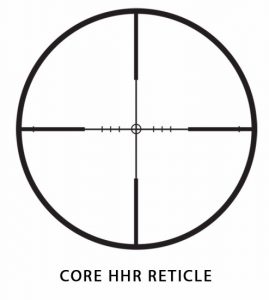 The HHR Hog Hunter reticle provides a .3 MOA central aiming crosshair at 7x for precise aiming. At 2x magnification, the outer 13 MOA circle is ideal for close range, quick acquisition shooting. At 7x magnification, the same circle is 4 MOA at 100 yards, which will cover 4” of the target, making it an ideal size to align with the small vital zone of the target. With the HHR Hog Hunter reticle, the duplex design was created to coincide with the average length of adult feral hogs. Obviously, the Sightmark Core HX 2-7×32 HHR Hog Hunter Riflescope can be used for more than just hunting and I will just leave it at that.
The HHR Hog Hunter reticle provides a .3 MOA central aiming crosshair at 7x for precise aiming. At 2x magnification, the outer 13 MOA circle is ideal for close range, quick acquisition shooting. At 7x magnification, the same circle is 4 MOA at 100 yards, which will cover 4” of the target, making it an ideal size to align with the small vital zone of the target. With the HHR Hog Hunter reticle, the duplex design was created to coincide with the average length of adult feral hogs. Obviously, the Sightmark Core HX 2-7×32 HHR Hog Hunter Riflescope can be used for more than just hunting and I will just leave it at that.
When I decided to mount the Sightmark Core HX 2-7×32 HHR Hog Hunter Riflescope on the CZ 527M Carbine, I had to take in consideration the size of the ocular lens housing. The length of the Sightmark Core HX 2-7×32 HHR Hog Hunter Riflescope is shorter than the Leupold VX1 3-9x40mm scope that was previously mounted on the CZ 527M, as is the diameter of the objective lens. I had no concerns about clearing the rear sight. I decided to use a set of Warne Bruno CZ 16mm Permanently Attached 1” Tube High Height scope rings that would accommodate most scopes with 42mm to 52mm objective lens housings. I had used a “medium” height of ring with the previous scope. I simply wanted to ensure myself that the scope would clear the bolt. The Warne rings added a slight bit of height, which made for a very comfortable gap for clearance, and placed the center-line of the scope 1.875 inches above the center-line of the bore.
Because of the increased eye relief, I was able to center the scope within the rings. While not necessary, I simply prefer it that way.
Some ballistic information follows. The Fiocchi 124-grain FMJ cartridge seems to do well in the CZ 527M, and it was selected to initially zero the scope. Below you will see the speculative ballistics for a one-hundred yard zero at one-hundred yards.

Below is an extension of the above ballistics out to two-hundred and fifty yards.

You may notice that the “Window of Opportunity” is from about twenty yards to one-hundred and thirty yards. The “Window of Opportunity” is a term that I coined for the distance in which the projectile would be within 1″ deviation from the point of aim. In my environment, where shots within one-hundred yards are the most common, this makes the rifle/scope combination something to have and to hold where POI is almost equal to POA without having to consider any amount of hold-over.
To tell the truth, I can’t see a way to improve on what I now have with the CZ 527M Carbine combined with the Sightmark Core HX 2-7×32 HHR Hog Hunter Riflescope.
If cost is a factor, expect to pay about $119 from on-line vendors. MSRP is $149. A link for more information regarding the scope can be found in RESOURCES.


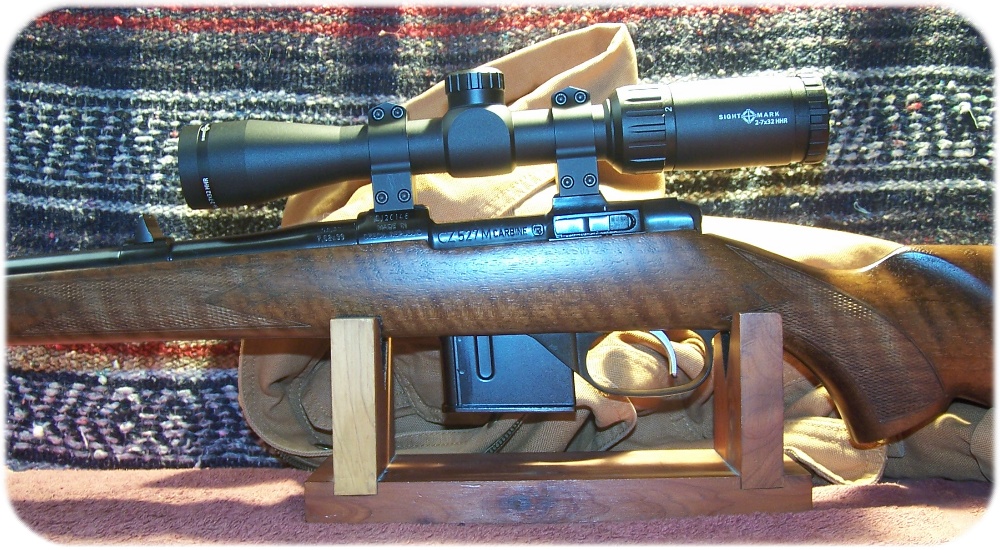
CONCLUSION:
Mounting a scope on the CZ 527M carbine has been a journey; a journey that I do not wish to travel again. The Leupold VX-1 3-9x40mm scope, although an excellent magnified optic, would have served me well, as would have the Nikon Prostaff 3-9x40mm scope had theyfit. The Leupold and the Nikon Prostaff 3-9x40mm scope will find their way, eventually, onto another firearm. The Sightmark Core HX 2-7×32 HHR Hog Hunter Riflescope is a better fit for the CZ 527M and me.
While I am somewhat anal about some things regarding magnified optics (like having the scope centered on the rings and centered on the ejection port, I have found that I can’t always get what I want. But, as the song says, I get what I need.
I hope that this articles helps you select a good scope/ring combination for your CZ 527M. You may choose a less expensive or more expensive scope, and that is totally up to you. Sometimes, the stumbling through a journey by one can make the journey much easier for another.
RESOURCES:
- ProStaff 3-9×40 Matte Nikoplex: http://www.nikonsportoptics.com/en/nikon-products/product-archive/riflescopes/prostaff-3-9×40-matte-nikoplex.html
- Leupold VX-1 3-9×40: https://www.leupold.com/hunting-shooting/scopes/vx-1-riflescopes/vx-1-3-9x40mm/
- Warne 1B1M 1 inch CZ 527 Fixed Medium Matte Rings: http://warnescopemounts.com/product/1b1m-1-inch-cz-527-fixed-medium-matte-rings/
- Scope Covers by ScopeShield®: https://scopeshieldcover.com/
- Wheeler Engineering FAT (Firearm Accurizing Torque) Torque Wrench Screwdriver: http://www.midwayusa.com/product/718023/wheeler-engineering-fat-firearm-accurizing-torque-torque-wrench-screwdriver
- Core HX 2-7×32 HHR Hog Hunter Riflescope (SM13067HHR): http://www.sightmark.com/product.php?item=446
![]()

